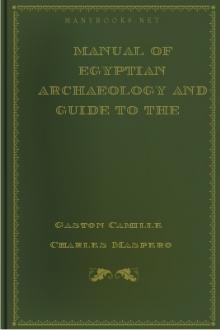Ancient America, in Notes on American Archaeology by John D. Baldwin (best thriller books to read .TXT) 📕

"It is in the form of a serpent, upward of 1000 feet in length, extended i
Read free book «Ancient America, in Notes on American Archaeology by John D. Baldwin (best thriller books to read .TXT) 📕» - read online or download for free at americanlibrarybooks.com
- Author: John D. Baldwin
- Performer: -
Read book online «Ancient America, in Notes on American Archaeology by John D. Baldwin (best thriller books to read .TXT) 📕». Author - John D. Baldwin
“In this place, also, there are stones so large and so overgrown that our wonder is incited, it being incomprehensible how the power of man could have placed them where we see them. They are variously wrought, and some of them, having the form of men, must have been idols. Near the walls are many caves and excavations under the earth, but in another place, farther west, are other and greater monuments, such as large gateways with hinges, platforms, and porches, each made of a single stone. It surprised me to see these enormous gateways made of great masses of stone, some of which were thirty feet long, fifteen high, and six thick.”
Many of the stone monuments at Tiahuanaco have been removed, some for building, some for other purposes. In one case, “large masses of sculptured stone ten yards in length and six in width” were used to make grinding stones for a chocolate mill. The principal monuments now seen on this field of ruins are a vast mound covering several acres, where there seems to have been a great edifice, fragments of columns, erect slabs of stone which formed parts of buildings, and several of the monolithic gateways, the largest of which was made of a single stone ten feet high and thirteen broad. Figure 55 gives a view of one. The doorway is six feet four inches high, and three feet two inches wide. Above it, along the whole length of the stone, which is now broken, is a cornice covered with sculptured figures. “The whole neighborhood,” says Mr. Squier, “is strewn with immense blocks of stone elaborately wrought, equaling, if not surpassing in size, any known to exist in Egypt or India.”
At Cuzco, two or more degrees north of Lake Titicaca, there are ruins of buildings that were occupied until the rule of the Incas was overthrown. Remains of the old structures are seen in various parts of the present town, some of them incorporated into new edifices built by the Spaniards. Cyclopean remains of walls of the Temple of the Sun now constitute a portion of the Convent of St. Domingo. In the days of the Incas, this temple stood “a circuit of more than four hundred paces,” and was surrounded by a great wall built of cut stone. Remains of the old fortifications are seen; and there is an extensive ruin here which shows what is supposed to be all that remains of the palace of the Incas. Figures 56 and 57 give views of remains of the ancient fortress walls at Cuzco. Occasionally there is search at Cuzco, by means of excavation, for antiquities. Within a few years an important discovery has been made; a lunar calendar of the Incas, made of gold, has been exhumed. At first it was described as “a gold breastplate or sun;” but William Bollaert, who gives an account of it, finds that it is a calendar, the first discovered in Peru. Many others, probably, went to the melting-pot at the time of the Conquest. This is not quite circular. The outer ring is five inches and three tenths in diameter, and the inner four inches. It was made to be fastened to the breast of an Inca or priest. The figures were stamped on it, and there “seem to be twenty-four compartments, large and small, including three at the top. At the bottom are two spaces; figures may or may not have been there, but it looks as if they had been worn away.” It was found about the year 1859.
The uniform and constant report of Peruvian tradition places the beginning of this old civilization in the Valley of Cuzco, near Lake Titicaca. There appeared the first civilizers and the first civilized communities. This beautiful valley is the most elevated table-land on the continent, Lake Titicaca being 12,846 feet above the sea level. Were it not within the tropics, it would be a region of eternal snow, for it is more than 4000 feet higher than the beginning of perpetual snow on Mont Blanc. Near it are some of the higher peaks of the Andes, among them Sorato, Illimani, and Sahama.
OTHER RUINS IN PERU.The ancient Peru conquered and robbed by Pizarro is now divided into Ecuador, Peru, Bolivia, and Chili as far down as the thirty-seventh degree of south latitude. Its remains are found to some extent in all these countries, although most abundantly in Peru.
The ruins known as “the Palaces of Gran-Chimu” are situated in the northwestern part of Peru, near Truxillo. Here, in the time of the first Incas, was an independent state, which was subjugated by the Inca set down in the list of Montesinos as the grandfather of Huayna Capac, about a century before the Spaniards arrived. For what is known of these ruins we are chiefly indebted to Mariano Rivero, director of the National Museum at Lima. They cover a space of three quarters of a league, without including the walled squares found on every side. The chief objects of interest are the remains of two great edifices called palaces. “These palaces are immense areas surrounded by high walls of brick, the walls being now ten or twelve yards high and six feet thick at the base.” There was in each case another wall exterior to this. Within the palace walls were squares and dwellings, with narrow passages between them, and the walls are decorated. In the largest palace are the remains of a great reservoir for water, which was brought to it by subterranean aqueducts from the River Moche, two miles distant. Outside the inclosures of these palaces are remains of a vast number of buildings, which indicate that the city contained a great population. The Spaniards took vast quantities of gold from the huacas or tombs at this place. The amount taken from a single tomb in the years 1566 and 1592 was officially estimated at nearly a million dollars. Figure 58 presents an end view of the walls at Gran-Chimu. Figures 59 and 60 represent some of the decorations at Chimu-Canchu.
Remarkable ruins exist at Cuelap, in Northern Peru. “They consist of a wall of wrought stones 3600 feet long, 560 broad, and 150 high, constituting a solid mass with a level summit.” Probably the interior was made of earth. On this mass was another, “600 feet long, 500 broad, and 150 high.” In this, and also in the lower structure, there are many rooms made of wrought stone, in which are a great number of niches or cells one or two yards deep, which were used as tombs. Other old structures exist in that neighborhood. Farther south, at Huanuco el Viego, or Old Huanuco, are two peculiar edifices and a terrace, and near them the faded traces of a large town. The two edifices were built of a composition of pebbles and clay, faced with hewn stone. One of them is called the “Look-out,” but it is impossible to discover the purpose for which it was built. The interior of the other is crossed by six walls, in each of which is a gateway, the outer one being finely finished, and showing a sculptured animal on each of the upper corners. It has a large court, and rooms made of cut stones. Connected with this structure was a well-built aqueduct. Figures 61 and 62 give views of the so-called palace and its ground plan. Figure 63 represents the Look-out.
Seven leagues from Lima, near the sea, are the much-dilapidated ruins, shown in Figure 64, of a large city of the Incas, which was built chiefly of adobes or sun-dried bricks. It is called Pachacamac. Ruins of towns, castles, fortresses, and other structures are found all about the country. At one place, near Chavin de Huanta, there are remarkable ruins which are very old. The material used here was like that seen at Old Huanuco. From the interior of one of the great buildings there is a subterranean passage which, it is said, goes under the river to the opposite bank. Very ancient ruins, showing remains of large and remarkable edifices, were seen near Huamanga, and described by Cieça de Leon. The native traditions said this city was built by “bearded white men, who came there long before the time of the Incas, and established a settlement.” It is noticed every where that the ancient Peruvians made large use of aqueducts, which they built with notable skill, using hewn stones and cement, and making them very substantial. Some of them are still in use. They were used to carry water to the cities and to irrigate the cultivated lands. A few of them were very long. There is mention of one which was a hundred and fifty miles long, and of another which was extended four hundred and fifty miles across sierras and over rivers, from south to north.
THE GREAT PERUVIAN ROADS.Nothing in Ancient Peru was more remarkable than the public roads. No ancient people has left traces of works more astonishing than these, so vast was their extent, and so great the skill and labor required to construct them. One of these roads ran along the mountains through the whole length of the empire, from Quito to Chili. Another, starting from this at Cuzco, went down to the coast and extended northward to the equator. These roads were built on beds or “deep under-structures” of masonry. The width of the roadways varied from twenty to twenty-five feet, and they were made level and smooth by paving, and in some places by a sort of macadamizing with pulverized stone mixed with lime and bituminous cement. This cement was used in all the masonry. On each side of the roadway was “a very strong wall more than a fathom in thickness.” These roads went over marshes, rivers, and great chasms of the sierras, and through rocky precipices and mountain sides. The great road passing along the mountains was a marvelous work. In many places its way was cut through rock for leagues. Great ravines were filled up with solid masonry. Rivers were crossed by means of a curious kind of suspension bridges, and no obstruction was encountered which the builders did not overcome. The builders of our Pacific Railroad, with their superior engineering skill and mechanical appliances, might reasonably shrink from the





Comments (0)